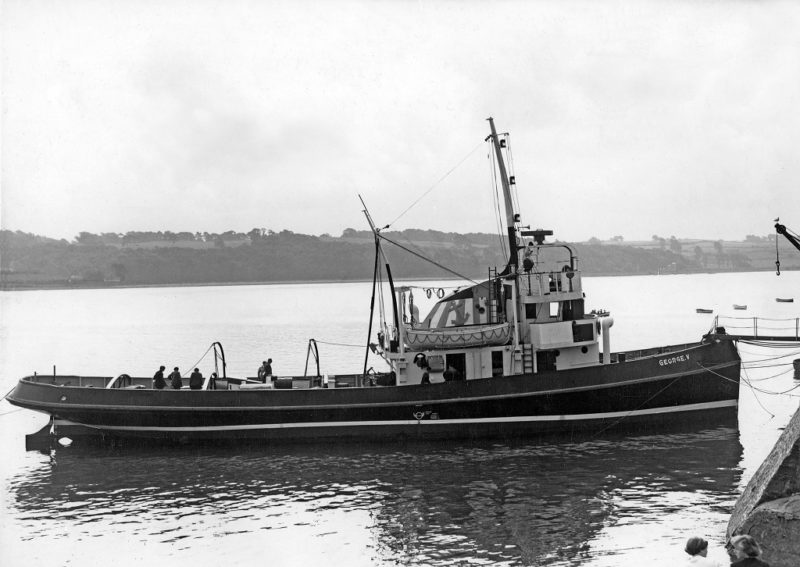
Coastal towage had always accounted for around 15% of the total revenue of Tyne towage. This figure compares with over 50% of total revenue for United Towing Ltd. (UTL) of Hull, with a big fleet of powerful deep sea tugs and around forty oil rig movements in the North Sea per year from 1967/68.
The Victorian and Edwardian days of sailing ships moving slowly up the English Channel or becalmed at the Downs on the South Coast or to the south of Flamborough Head gave much work to steam tugs ‘seeking’ work from the Tyne to tow them to their ports of destination on the North East Coast of England. When a sailing ship was sighted that was bound for North East Coast ports, bargaining over the price of a tow would take place until an acceptable figure was reached.
I knew the Master of one of these tugs, Capt. Hector Stewart (1900-1991), Master of the famous Tyne rescue tug George V, who performed over twenty rescues of ships in distress in gale force conditions in the North Sea in his illustrious career as Commodore of France, Fenwick Tyne & Wear Co. Ltd. from 1939 until his retirement on the last day of 1968. Capt. Stewart had become a tug Master at only 26 years of age, and on his rescue missions, George V on occasion lost lifeboats and accommodation doors ripped off their hinges and mountings and swept overboard in the Force 10 gales and high seas.
The triple expansion steam powered tug George V of 225 grt was built by the famous tug builder of J. P. Rennoldson & Sons Ltd. beneath the Lawe Top at South Shields, where Capt. Hector Stewart lived, and was completed in January 1915 for Redhead Tugs, which was subsequently amalgamated into France, Fenwick Tyne & Wear in 1944. She served the Royal Navy for six months in 1915 and again between 1917 and 1919, and on many rescues during World War II.
She was then converted into a motor tug at Appledore in Devon with a 12 cylinder 2SCSA oil engine by General Motor Corporation of Cleveland (USA) in 1954. In 1978, she was sold to Coastal Marine Services Ltd. of Plymouth and worked at various South Coast ports including Poole and Weymouth, before her sale in 1981 to Mr. N. E. Murray of Queenborough in Kent. She was given a warm welcome by her former Tyne tugs in November 1978 when she put into the Tyne for fuel and water while towing the Isle of Man ferry Snaefell to Blyth for breaking up.
She was eventually laid up at Chalk Wharf at Queenborough in a very rusty state near the Glass Containers Ltd. factory and was broken up at Queenborough in 2007 after a long career of 92 years.
A very similar tug with the same name of George V of 188 grt had been completed in September 1910 for Redhead Tugs for towing sailing ships, steamers and barges. She sailed from the Tyne in 1913 to Vigo on the Atlantic coast of Spain to help the Dutch ocean going tug Poolzee bring home to the Tyne the heavily laden sailing ship Glenmorven with a cargo of iron ore, which had unfortunately gone aground and damaged her rudder. George V was the stern steering tug until heavy weather blew up in the Bay of Biscay, and the running crew aboard the sailing ship abandoned her for the safety of the Dutch tug, which then left the area. George V reconnected with the tow and got her into Falmouth to stock up with water, food and fuel.
The tow was successfully completed to the Tyne with a large salvage award made to her owners and part distributed to the crew. George V was sold to Russia in 1914, with the equally successful George V (2) replacing her in 1915, and towing ‘A’ class and other Cunard liners into the Tyne for modernisation refits in the early 1920s.
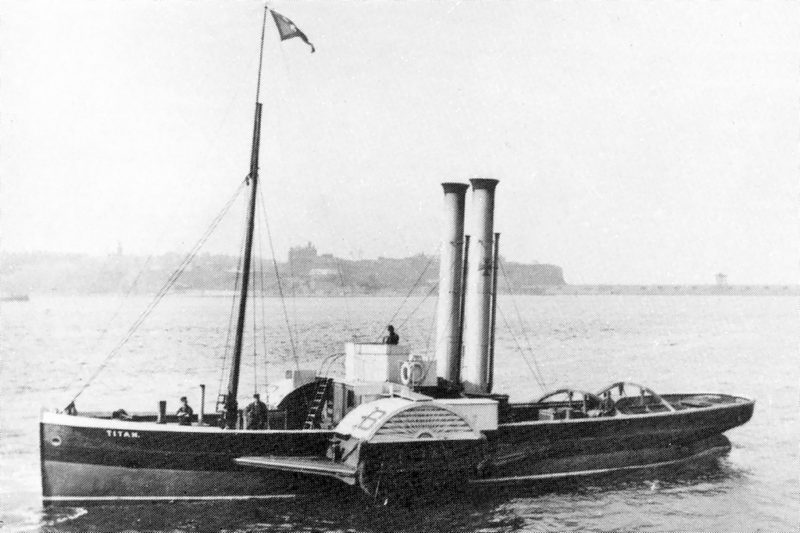
EARLY TYNE TUG FLEETS AND TOWS
Towing has its roots in the Tyne as the first recorded towing of a deep sea sailing ship from the river was in July 1818 when the steam tug Perseverance owned by Joseph Price of Gateshead towed a sailing ship to sea from Newcastle to a point over two miles from the bar, a distance of over thirteen miles in 140 minutes. There were thirty Tyne tugs in 1830 and fifty years later the total was 43 tugs, with 53 tugs operating at the turn of the century to reach a peak of 68 tugs in 1923. Many Tyne tug owners in the 1860s were regularly towing fully loaded collier sailing brigs out of the river for some distance to catch the wind and shorten their voyages, allowing the sailing brigs to complete an average of thirteen round voyages per year to the Thames instead of only eight voyages per year without towing. The tugs were thus very necessary to the Tyne coal trade, as the twin long piers that formed the only harbour of refuge between the Humber and the Forth were not completed until 1895. The treacherous Black Middens rocks at Tynemouth did claim many lives from the crews of sailing ships and steamers that ran into difficulties. Five ships were wrecked within three days of storms in 1864, resulting in 34 deaths of seamen within close sight of the shore, and also resulting on 5th December 1864 of the formation of the Tynemouth Volunteer Life Brigade.
John Batey sent one of his steam tugs to tow the iron sailing ship Jupiter from Hamburg to the Tyne in October 1894 in three days. The tugs of Robert Lawson were known as the Black Diamond Line of tugs as a black diamond was painted on their cream funnels. Two Lawson tugs towed a dozen British, Norwegian, French and German barques and steamers between 1910 and 1913 on coastal tows to and from the Tyne to ports in France, Germany, Norway and Scotland, as well as to the Downs and Beachy Head on the South Coast. Several Tyne tugs were requisitioned for wartime towing by the Government, and on their return in 1918 a process of amalgamation of the many remaining Tyne tug boat family companies began to take place e.g. John and James Ridley had started with one tug in 1848, Joseph Crosthwaite had started with one tug in 1854, Robert Redhead had started with one tug in 1855, Thomas Allan Dry had started with two tugs in 1857, John Coulson had started with two tugs in 1866, and George Brown had started with one tug in 1888.
One of the most beautiful sailing ships in the world was towed into the Tyne from Bremerhaven on 31st August 1903. This was the Norddeutscher Lloyd (NDL) schoolship Herzogin Cecilie built in 1902 by the Rickmers shipyard in Bremerhaven. She had sailed on her maiden voyage with salt from Bremerhaven and she reached Montevideo on 20th August 1902 after a passage of 55 days. She had sustained storm damage and spent six weeks at Montevideo making repairs, and finally reached Astoria on the Columbia river on 13th December 1902. She had a crew of 37 and 44 cadets, who gained their first introduction to the sea on this lovely sailing ship. While in the Tyne to load coal, there was much admiration for the well disciplined cadets, all of whom visited Alnwick Castle at the invitation of the Duke of Northumber-land. She sailed from the Tyne under tow by a Tyne tug on 18th September 1903 for three days for the Isle of Wight, and then had a long passage of five weeks to reach the South Atlantic, and after rounding Cape Horn in severe storms she reached San Francisco on 11th January 1904 after a passage of 112 days.
France of 5,500 dwt was built in 1890 by D. & W. Henderson at Glasgow for A. D. Bordes and made her maiden voyage to the Chilean port of Valparaiso to load nitrates in 63 days. France made her last visit to Albert Edward Dock in March 1901 to load a full cargo of coal and was towed for some distance from the port by local tugs. Unfortunately, she did not reach her destination of Valparaiso as she was found two months later deserted and on her beam ends off the South American coast. The German barque Hebe had picked up her crew and landed them at Valparaiso in June 1901. A tug was despatched to search for the five masted barque, but she was not seen again.
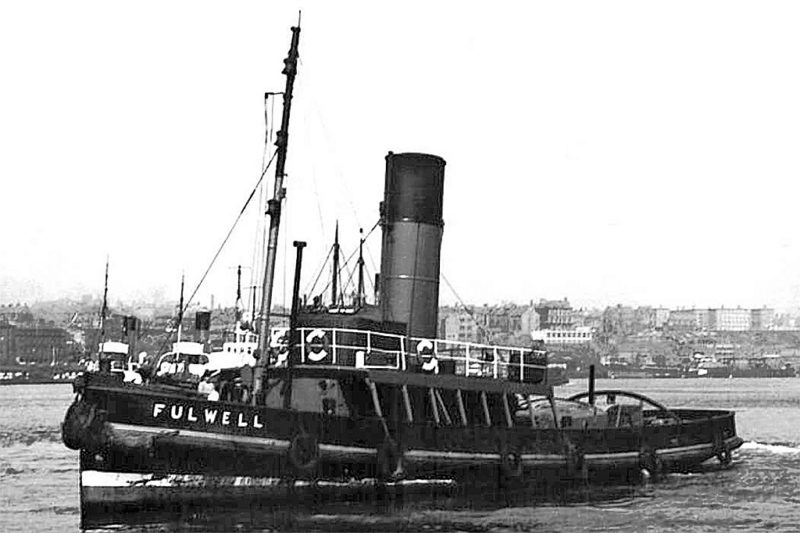
One of the last sailing ships to arrive under tow in the Tyne was the four masted Clyde built Archibald Russell of 2,354 grt built in 1905 by Scotts Shipbuilding and Engineering Company at Greenock at a cost of £20,750. She sailed later in her career for the famous sailing ship owner Gustav Erikson of Mariehamn in the Aland Islands. She arrived under tow in the Tyne for a very different reason to be broken up at Gateshead by J. J. King & Company in 1949. She had a steel hull with two long bilge keels of 120 feet in length, and was rigged with royal sails over double top gallant sails.
AMALGAMATION OF TYNE TUG FLEETS
Chief amongst these were the formation of a company on 1st March 1918 with the most classic funnel colours that were ever given to a tug company. This was the new France, Fenwick Tyne & Wear, taking its name from a famous collier owning company that also owned the Sunderland Towage Company with funnel colours of a policeman’s armband of vertical light blue and white bands. This fleet of eight tugs was then merged with the North Shields based Anchor Tugs, which sported a blue anchor on a white funnel with a black top on its four tugs. The blue anchor and black top were then cleverly interwoven with the Sunderland Towage Company colours to give a classic and much admired funnel.
Another very important merger took place on 28th February 1920 when the Lawson Steam Tug Boat Company, with cream funnels carrying a black diamond and with a black top, merged with the fleet of John Batey with yellow funnels carrying a blue Maltese Cross. Lawson-Batey Tugs Ltd. was formed with a big combined fleet of eighteen tugs. The surrendered German battleship Nassau was towed into the Tyne in 1920 for breaking up from the Firth of Forth by George V of Redhead Tugs, and Great Emperor, Malta and Washington of John Dry Tugs. The collier Crackshot owned by Witherington & Everett of Newcastle grounded on the Black Middens on 21st January 1926 in thick fog. She was refloated during the next day, but the tug Corsair of 153 grt and built in 1892 was also stranded and damaged after going to the assistance.
The process of amalgamation and rationalisation increased due to the shortage of work to be found in the poor freight rates of the 1920s, and continued with the other Tyne tug fleets of the Ridley Steam Tug Co. Ltd., Redhead & Dry’s Tugs Ltd., Joseph Crosthwaite of North Shields, Robert L. Cook, Anthony Irwing and Axel Andersen, the latter having settled in 1899 on Tyneside from Denmark. These fleets in 1932 owned the following tugs:-
France Fenwick Tyne & Wear Co. Ltd. with the tugs Cleadon, Corsair, Criccieth, Cullercoats, Dunelm, Hendon, Iron, President, Roker, Souter, Wearmouth and Wexford, with several of the fleet serving at Sunderland. Hendon was a coastal rescue tug of 241 grt from the Lawe yard of J. P. Rennoldson & Sons Ltd. of South Shields, and had an exact sister Marsden completed by the same yard in October 1923 but sold to owners in Argentina in 1926.
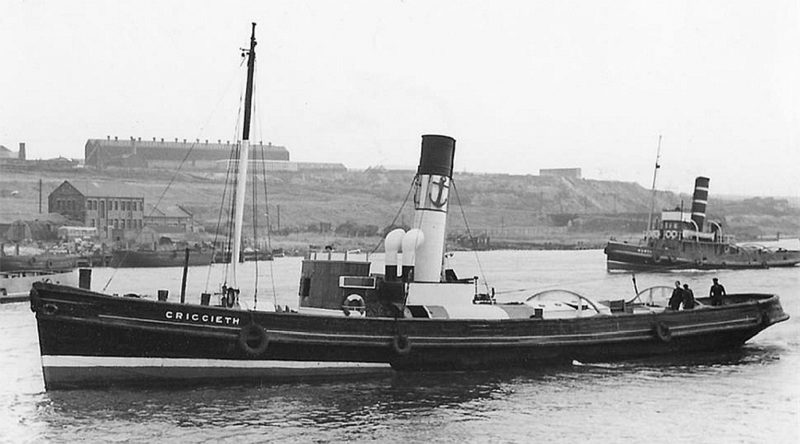
Lawson-Batey Tugs Ltd. with the tugs Comet, Francis Batey, Homer, Joffre, Langton, Mentor, Nestor, Plover, Titan and Ulysses. Joffre was a coastal and harbour tug of 260 grt, which unfortunately ran aground at Bolt Head in Devon on 26th May 1925 while on a voyage from Falmouth to Antwerp, and was stuck fast for four days until refloated, but she had suffered bad hull damage before being towed from Falmouth to the Tyne for extensive repairs at South Shields. She had been requisitioned by the Government for coastal towing between 23rd November 1917 and 15th March 1919.
Ridley Steam Tug Co. Ltd. with the tugs Granville, Haakon, Isaac Wilson, Marty and William Fallows, all with black funnels with three thin white bands, the same funnel colours of the Bergen Line, whose passenger and mail ferries were always handled to their berth at Tyne Commission Quay by the Ridley Steam Tug Co. Ltd. The company in the 1920s also handled the passenger and mail ferries at Newcastle Quay of Swedish Lloyd, with some of the fleet wearing similar funnel colours to Swedish Lloyd.
Redhead & Dry’s Tugs Ltd. with the tugs Ben Ledi, Conqueror, Gauntlet, George V, Great Emperor, Malta, Snowdon and the twin funnelled Washington. The fleet had yellow funnels with a black top.
Robert L. Cook with the tugs Cinema Star, Clarence and Stag with funnel colours of white with a black top and a five pointed red star on the white part.
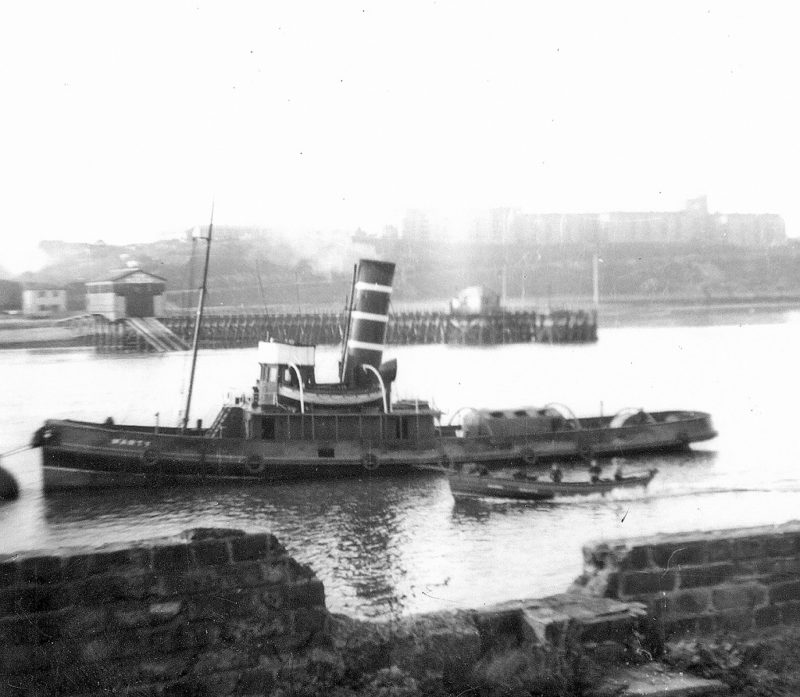
Joseph Crosthwaite (Tugs) Ltd. of North Shields with the tugs Champion, Lewis Crosthwaite and Joseph Crosthwaite and black funnel colours, but the family had no connection with William H. Crosthwaite of Middlesbrough.
Anthony Irwing with the tug Conqueror that was broken up in 1934 with a black funnel carrying a white logo.
Axel Andersen with the tug Enable wearing a black funnel and two red and one white band, the Colours of Denmark as the owner was originally Danish.
The White Star liner Olympic was towed into the Tyne on 13th October 1935, and the Cunard liner Berengaria on 18th December 1938, towed by a flotilla of tugs to be broken up at Jarrow and thus alleviate the huge employment in the town. The compassion of one man, Sir John Jarvis, the High Sheriff of Surrey, had paid for the purchase of the liners after the closure of the famous Palmer’s shipyard in 1930, after the Government refused to help ease the hardship of unemployment and poverty. The hull of Berengaria was cut down to a lower section level including her double bottom, and then laid up until after World War II, she was then towed up to Rosyth for final breaking up.

TYNE TUGS WARTIME and POST-WAR SERVICE
George V was in high demand as a rescue tug to tow in the many torpedoed and bombed casualties of World War II. The tanker Atheltemplar hit a mine to the south east of the Tyne on 14th December 1939 and was towed to a position just south of the Tyne entrance by two Lawson-Batey tugs, with George V and Great Emperor assisting in beaching her after 43 hours of towing in difficult conditions. She was then lightened and towed into the Tyne in one of the most famous Tyne tug rescues of all time.
The old Belgian tramp Brabo, built back in 1889 at Glasgow as Frederica, was loaded with tightly baled paper pulp in 1940 when she set off a magnetic mine while entering the Tyne. The holds were slowly flooding but she had enough way on her for her Master to steer clear of the treacherous Black Middens and ground her on the south side of the harbour, by which time her decks were almost awash. George V later assisted in the complex refloating of the vessel as the pulp had swollen by immersion and many of her rivets had started to give due to explosives having to be used to loosen the cargo as grabs had made no impression. As the pulp was discharged the pressure eased, but by then Brabo had settled down further with the hatches awash at half tide. Cofferdams had to be built around the vessel as she was in shallow water, and when the weather had improved George V started pulling, the suction was broken and she was towed to a more sheltered position. She was then completely discharged and pumped out enough to be dry docked after being aground for six months.
George V was sent on 6th December 1939 to rescue the British tramp Eskdene of 3,829 grt and built by the Bartram yard at Sunderland for the Dene Shipping Co. Ltd. The torpedoed ship was down by the head and was being kept afloat by her cargo of timber. Eskdene was taken in tow and in worsening weather she arrived at the Tyne entrance, but as she crossed the bar an explosion onboard her caused further damage. George V and Hendon immediately went to full speed ahead to beach the casualty clear of the main channel.
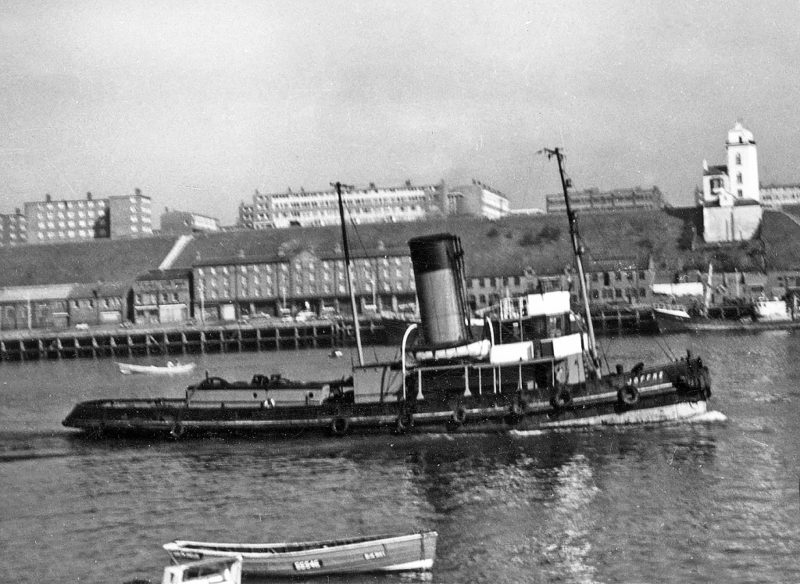
The coaster Nutfield had been beached after a large hole had been blown in her hull by enemy action, and George V and Robert Redhead succeeded in refloating her on 23rd December 1942 and towing her into the Tyne for dry docking and repairs. George V and five other tugs belonging to Redhead & Dry’s were taken over by France Fenwick Tyne & Wear in May 1944 and then wore their distinctive colours after the end of the war.
The Court Line tramp Framlington Court, built in 1924 and carrying a cargo of iron ore, was in collision on 8th July 1943 and was holed in the engine room and very low in the water with her rudder jammed. She was taken in tow by George V and the Dutch tug Amsterdam, however two tugs were not enough to tow her safely and she was beached temporarily on the Herd Sand inside the harbour. She was patched up and later towed upriver for dry docking.
Many very old paddle tugs were sent for breaking up in the decade after the end of World War II. Dunelm of 165 grt had been built in 1883 by Hepple & Company at North Shields and served all of her 73 year career for the Tyne Improvement Commission and France Fenwick Tyne & Wear. I remember seeing her move under her own power for the last time in May 1956 upriver to Gateshead for breaking up. Four standard ‘Empire’ harbour tugs of 240 grt had been managed during the war by Tyne tug owners, and Empire Paul joined France Fenwick Tyne & Wear in April 1949 as Beamish. She represented the British towage industry at the 1953 Spithead Review under the command of Capt. Hector Stewart, Fleet Commodore, and who had previously been in command of Hendon for 17 years. Empire Cherub joined Lawson-Batey Tugs Ltd. in July 1946 as Tynesider and kept her famous name for 24 years until broken up at Blyth in March 1970.
Beamish was converted to diesel propulsion in October 1963 by R. B. Harrison at Bill Quay. A fleet of three American built diesel tugs renamed Grangetown, Ryhope, Cornhill, with Whitburn joining later in 1964, were all in service on the Wear. New diesel powered tugs that had been built at Appledore in Devon and in Germany joined the Tyne tug fleets. These were the sisters Alnwick, Bamburgh, Prestwick, Marsden and Ashbrooke of 119 grt and 1,080 bhp, and Quaysider of 137 grt and 1,200 bhp, and the sisters Impetus and Maximus of 141 grt and 825 bhp. Capt. Hector Stewart took command of the rebuilt diesel powered George V of 1,080 bhp for the first time in August 1954 on completion of her conversion at Appledore, and she was on display to the towage industry and the public at the Tower of London on 23rd March 1955.
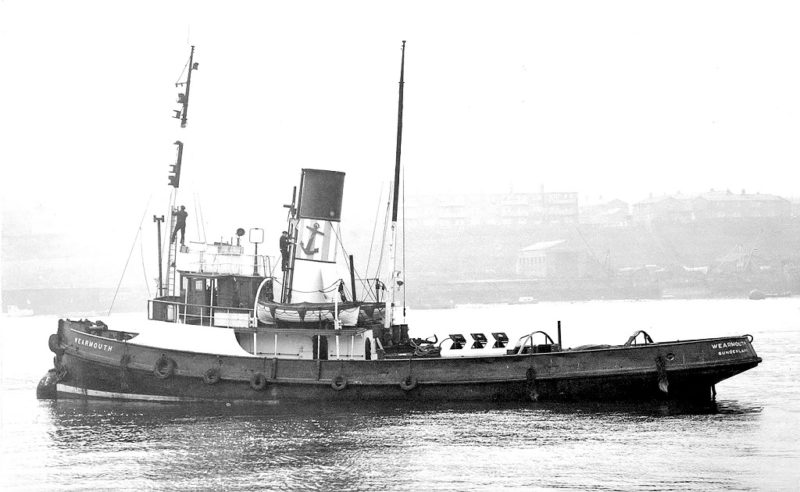
The charter company of Tyne Tugs Ltd. was formed on 1st January 1959 to operate a joint fleet composed of the tugs of France Fenwick Tyne & Wear, Lawson-Batey Tugs Ltd. and Ridley Tugs Ltd. The fleet were to wear uniform funnel colours of red with a black top, with two dozen tugs repainted in these colours. Prestwick kept her very handsome France Fenwick Tyne & Wear funnel colours while in service on the Wear, and Westsider was the former Tees tug Charing Cross and Joseph Constantine built in 1913 and broken up in 1960.
The steam tug Eppleton Hall of 166 grt had been built in 1914 for the Lambton and Hetton Collieries Ltd. at Sunderland, and continued in service on the Wear after her sale to France Fenwick Tyne & Wear in 1945. After three years of service at Seaham Harbour, she was sold for breaking up at Dunston on Tyne, but was rescued from the scrapyard by Scott Newhall and refitted to cross the Atlantic to San Francisco via the Panama Canal between September 1969 and her arrival in March 1970. She is on display today in good condition at the Fisherman’s Wharf Maritime Museum in San Francisco. The France Fenwick tug Cleadon of 150 grt was broken up at Gateshead in February 1968 after a career of over 68 years, having been built for Alexandra Towing of Liverpool in 1899. Cleadon joined the Wear tug fleet in 1930 and was raised for further service in 1955 after sinking off Sunderland Fish Quay.
George V had an impressive record of rescues and coastal tows throughout the post war period, starting with the refloating of the Shell tanker Diloma, which had struck Hendon Rocks off Sunderland, and working in tandem with Cullercoats, Hendon and Wearmouth on 18th March 1947. She was one of the tugs towing the aircraft carrier Albion from the Tyne to Rosyth when the tow was in collision with the coaster Maystone on 18th October 1949 four miles from the Longstone Lighthouse on the Farne Islands, with severe loss of life on the coaster when she sank. Albion was badly holed and a larger Admiralty tug was sent from Rosyth to help with the tow. George V was chartered to Westminster Dredging for coastal towing during 1955/56 and again in 1959, with many transits of the Caledonian Canal with dredgers en-route to Inverness, Preston, Liverpool and Avonmouth, with other tows to Leith and Southampton. She frequently was sent to the Caledon shipyard at Dundee to tow new ships to the Tyne and the Wear for the installation of their engines including six cargo-liners of Prince Line for Mediterranean service, the Watts Watts tramps Woodford, Wendover and Wanstead, and the Cory colliers Corsea and Corsound.
George V took a severe buffeting from Force 10 gales in 1963 while towing the German coaster Eifeltal of 999 grt from the middle of the North Sea towards St. Abbs Head and then May Island and into the safety of Dundee. She lost an accommodation door ripped off its hinges and swept overboard. The Swiss tramp Nyon of 4,956 grt ran aground near St. Abbs Head on 15th November 1957 having badly mistaken her turn into the Firth of Forth. Capt. Hector Stewart was first on the scene to survey the casualty, which was firmly trapped by the bows on rocks that extended up to number three hold. Capt. Stewart obtained the agreement for Lloyd’s Open Form of Salvage Agreement, which then only allowed two Dutch tugs that arrived later to be employed as co-salvors. Cutting gear was obtained from Rosyth Dockyard to cut the vessel in half and salvage the stern half, which was successfully completed on 27th November, with half ship Nyon arriving in the Tyne a day later.
George V had handled well over one thousand tows in her career as a diesel engine tug, including the rescues of the cable ship Edouard Suenson off Newbiggin, and several British and Swedish coasters, either aground or in distress at sea, the last being the Swedish coaster Rigon rescued in January 1969. The Bergen Line passenger and mail ferry Venus was pulled off the Groyne at South Shields on 23rd May 1964 after six hours of hard pulling. Large tankers and bow and stern halves of bulk carriers were towed from the Wear to the Tyne for joining together, while a charter from a television company to film the raising of a German submarine from the shallow water of the Dogger Bank was very unusual to say the least.
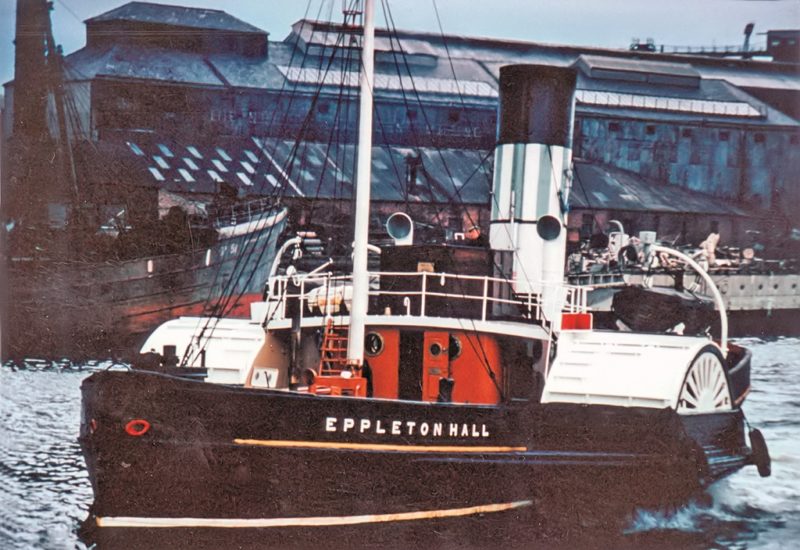
In 1973, France Fenwick Tyne & Wear had a fleet of ten tugs of which five worked on the Tyne and five on the Wear. Tyne Tugs Ltd. had a fleet of eleven tugs on charter, with Alnmouth, Alnwick, Ashbrooke, Bamburgh, George V and Appelsider, Ironsider, Northsider, Quaysider and Westsider from Lawson-Batey Tugs Ltd. On 10th March 1974, the United Towing Ltd. (UTL) Statesman of 1,167 grt and built in 1966 was called to the scene at the Black Middens of the grounding of the Houlder Brothers offshore vessel Oregis, equipped with heavy cranes and a moonpool, after she had sailed from the yard of Smith’s Dock Co. Ltd. and conversion from an ore carrier. An inflatable rubber boat was launched by Statesman in order to establish a connection and unfortunately capsized in the heavy surf and a young seaman was drowned. Northsider and other Tyne tugs tried without success to refloat her, with Northsider also aground on rocks in front of Knotts Flats. After refloating, both Oregis and Northsider needed extensive hull repairs, and only six months later the five hold Greek cargo ship Aliki of 8,453 grt and 12,500 dwt grounded at the same place in heavy seas and gale force winds, and was refloated by seven tugs on the next high tide. Aliki had been built in 1953 at Burntisland as Master Nicos for Greek owners, and was renamed Khios Belle in 1958 and Aliki in 1972 again for Greek owners, and arrived at Cartagena on 3rd April 1979 for breaking up. She was powered by a six cylinder 2SA Sulzer diesel engine that gave a service speed of 13.5 knots.
Two more powerful tugs of 3,180 bhp were on order at the Hessle yard of Richard Dunston Ltd., of which Cragside of 266 grt was completed in December 1976 for coastal towing, while her exact sister Hendon did not join the Tyne fleet but was sold to Alexandra Towing in 1977. Lawson-Batey Tug Ltd. negotiated the purchase of France Fenwick Tyne & Wear in 1977, which included the purchase of all five tugs working on the Wear and all five tugs on charter to Tyne Tugs Ltd. The fleet of Tyne Tugs Ltd. continued to wear the funnel colours of red with a black top until 1986, having first been painted up on the fleet in 1959. There were seven tugs in the Tyne Tugs Ltd. fleet in 1986.
Funnel colours of all tugs working on the Tyne and Wear were changed in 1986 to the yellow colour with a blue Maltese Cross of Lawson-Batey Tugs Ltd., including the new tug Wearsider completed in late 1980 and Holmsider completed in June 1984. Tynesider and other Tyne tugs including Seasider completed in March 1985 were chartered out for Teesside towage and to Glenlight Shipping Ltd. of Glasgow to find coastal work, with Tynesider towing barges around Loch Fyne and the Clyde estuary with forestry products and sawn timber, and she ran aground on 3rd April 1994 on Skate Island in Loch Fyne. She was towed off two days later but sank immediately, was then raised and towed to Troon for breaking up.

The Tyne fleet of tugs went through four changes of ownership between 1982 and 2001, first to the Clyde Shipping Co. Ltd. in 1982, secondly to Cory Towage Ltd. in May 1995, thirdly to Wijsmuller of Holland in June 2000, and lastly to Svitzer Marine Ltd. of Denmark in July 2001. Svitzer Marine Ltd. is a global towage firm with a huge worldwide fleet numbering in the hundreds of tugs, and is wholly owned by Maersk Line of Denmark. The South Shields office closed in 1995 with all tug movements on the Tyne then controlled by radio link from the Middlesbrough office of Cory Towage Ltd. The Clyde Shipping Co. Ltd. tug Flying Spindrift worked on the Tyne from 1993 until moved to Cardiff, with tugs then moved around the British coast to suit the diminishing amount of harbour towage available. Tyne tugs assisted with the arrival and sailing of giant ships for conversion to shuttle tankers and FPSOs (Floating Production Storage & Offloading vessels) e.g. Bonga, North Sea Producer, Bleo Holm, Haewene Brim, Uisge Gorm and Enquest Producer, as well as many oil rigs towed by very powerful North Sea offshore tugs.
Danish, Tees, Liverpool, and Southampton tugs, and several Svitzer Marine Ltd. tugs have worked on the Tyne during the twenty years of Svitzer domination since 2001 e.g. Svitzer Lyndhurst, Svitzer Maltby, Svitzer Mercia, Svitzer Sword and Svitzer Redbridge. The last Tyne tugs with traditional names were sold in 2000, with Cragsider going to Beirut owners as Baltagi XX after 24 years of service, and Hillsider, the former Lady Theresa of 160 gt and built by Cochrane in 1987 for Humber towing and purchased in 1994, sold to Fairplay Gmbh and renamed Fairplay XI. The Tyne tug fleet was reduced from four tugs to three tugs in 2007, and the fleet now comprises Forth, the former Cleveland Cross built in 1989, and the newer tugs Svitzer Tyne and Svitzer Sun.
SMS Towage Ltd. of Hull had towed the barge Stema Barge 2 from a point two miles off Rye Harbour to the Tyne in December 2014 using their tug Welshman, the barge having been employed off Dymchurch. The company later made an entry into Tyne harbour towage at the end of 2020 when three of their tugs, Roman, Pullman and Nobleman based on the Tees, arrived to take charge of a ship sailing out of the Tyne instead of it using the three locally based Svitzer Marine Ltd. tugs. SMS Towage Ltd. had been set up by Paul Escreet, the former Commercial Director of United Towing Ltd. (UTL), after the parent company of UTL had withdrawn the company from towing in 1992. A rig moving service was offered until three tugs were purchased in 2002/03 and renamed Tradesman, Trueman with a Swedish tug renamed Riverman, and all three operated from Hull with a Head Office at nearby Hessle. More tugs were purchased, and in 2012 the company started to service harbour towage at Bristol Channel ports, and Belfast harbour from 2013, with Portsmouth following in 2017. The three tugs mentioned above were based on the Tees from 9th November 2020, and made the short trip northwards to the Tyne a month later. SMS Towage Ltd. currently have a big fleet of eighteen tugs named with the same ‘Man’ nomenclature that was formerly used by UTL.

NON SHIP HANDLING TUG FLEETS
There were many tugs that were employed in towing dredgers, hoppers, floating cranes, oil rigs, wind turbine foundations, and offshore construction equipment of all types. These, except for those used in towing the dredgers and hoppers and floating equipment of the Tyne Improvement Commission, were used in coastal towing and several tugs still do so today. The Tyne Improvement Commission had a big fleet of paddle tugs built in the 1850s and 1860s shortly after it was formed, but these were broken up in the decade from 1910 to 1920. After World War II, there were only a few tugs left e.g. Coble Dene of 125 grt built in 1883 and named after an area of Albert Edward Dock at North Shields and broken up in 1953, and the last two steam tugs were sold off in 1955.
Osprey Towing Ltd. was formed in 1995 and is part of the large crane, engineering and project work Osprey Group, and employed three powerful coastal tugs towing barges from bases at Howdon on Tyne, and Avonmouth and Portbury. Osprey Boxer of 140 grt and 40 tonnes bollard pull was built by Damen Shipyards in 2009, Osprey Fighter of 160 grt and 45 tonnes bollard pull arrived in the Tyne in January 2008 as a new tug towing a large barge, and Osprey Fearless of 360 grt and 4,080 bhp with a bollard pull of 60 tonnes was completed at Navia in Spain in 1997 and was owned by Osprey between 2014 and 2017. The barges that they used for coastal towing came in many standard sizes from 30 metres in length up to 110 metres, and also carried ‘Osprey’ names e.g. Osprey Carrier. A tug and barge service operated from Northern European ports to North African ports, and the first Osprey tug had been the Admiralty ‘Dog Class’ tug Alsatian renamed Cumbrae, owned between 2002 and 2010 with her twin engine exhausts repainted yellow with a black top. Carmet Marine Services Ltd. and Holyhead Towing Ltd. have also been contracted with a lot of coastal tows into the Tyne since the 1980s.
Tyne Towage Ltd. used small tugs employed on dry docking and river work from 1986, and their larger tugs came in very handy for towing the many big sailing ships out of the river during the Tall Ships Races of 1986 and 1993. These tugs were T. H. Dev of 159 grt and built in 1952 as Plateau for the Port of London Authority, the former Tees tug Golden Cross of 132 grt built in 1955 and renamed Dunheron, the Manchester Ship Canal tug MSC Sovereign of 147 grt and built in 1956, the Cory tugs Cedargarth, Hazelgarth and Pengarth built between 1959 and 1962 and given family names of the owning Devlin family, Pullwell Bravo of 126 grt and built in 1955 as Hendrik II, the pusher tug Pushy Dev of 145 grt and built in 1956, and the former Cleveland Endeavour fireboat of the Tees and Hartlepool Port Authority renamed as the pusher tug Sara D. Mikey Devlin sold out to Svitzer Marine Ltd. in 2001 on the Svitzer takeover of Tyne towage, with his fleet of small tugs then disposed of by Svitzer, but his useful river tug base between the former Jarrow Staiths and the A. & P. Shipyard is the current Svitzer base.
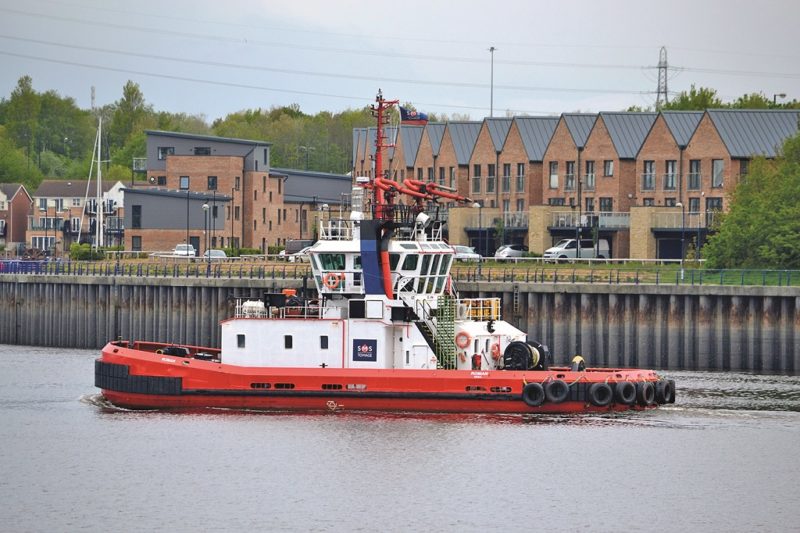
POSTSCRIPT
The tug George V was one of the most famous of all of the many famous Tyne tugs, and her twenty rescue missions were legendary. I formed a small group in July 1987 to try and rescue her for restoration and tow her back to the Tyne from Queenborough. I was quoted £3,000 for this tow from Tyne Tugs Ltd., including the cost of lifting her on to a barge to prevent her from sinking en-route. This was beyond the funds of the group, and I was told by people in the know that the only way the project was viable was if I lived on the tug!
The dangers of oil pollution leaking from an old tug was brought home to me when the group trying to rescue and restore the Tees tug Golden Cross of 1955 at Ardentinny on Loch Long near the Clyde in Scotland were faced with a fine of £400,000 when she twice ran aground while laid up and polluted the waters of the loch, with an appeal against the fine turned down.
There have been many very great advances in tug propulsion over the years e.g. the Kort nozzle in 1932, and the Voith-Schneider Schottel type of propulsion in the 1950s. The latter allowed tugs to spin around in a circle while on a stationary axis. This better manoeuvrability was need to turn huge tankers, bulk carriers and other ships around in a 180 degree turn in restricted waters using four tugs. However, it was the widespread practice of fitting bow and stern thrusters into the vessels that they used to tow that determined the ever diminishing number of harbour tugs. I have seen in my lifetime the big fleet of fifty Tyne tugs reduced to only three tugs.

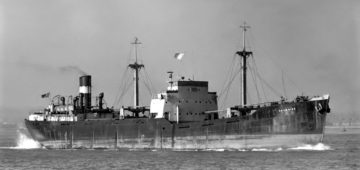


Comments
Sorry, comments are closed for this item